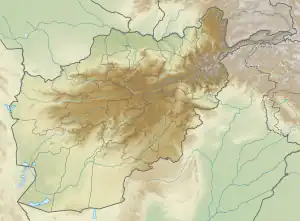| Zorkul | |
|---|---|
 The western end of lake Zorkul, where the Pamir River starts its course. | |
 Zorkul  Zorkul  Zorkul | |
| Location | Pamir Mountains, Hindu Kush |
| Coordinates | 37°27′N 73°42′E / 37.450°N 73.700°E |
| Primary outflows | Pamir River |
| Basin countries | Tajikistan |
| Surface area | 38.9 km2 (15.0 sq mi) |
| Surface elevation | 4,130 m (13,550 ft) |
| Official name | Zorkul Lake |
| Designated | 18 July 2001 |
| Reference no. | 1086[1] |
Zorkul (Persian: زارکول; Tajik: Зоркӯл, romanized: Zārkul) is a lake in the Pamir Mountains that runs along the border between Afghanistan and Tajikistan.
Geography

Lake Zorkul extends east to west for about 25 km. The Afghanistan–Tajikistan border runs along the lake from east to west, turning south towards Concord Peak (5,469 m), about 15 km south of the lake. The lake's northern half lies in Tajikistan where it is protected as part of the Zorkul Nature Reserve. Out of the lake, towards the west, flows the Pamir River, tracing the Afghan-Tajik border. It is therefore a source of the Amu Darya or Oxus River. The Great Pamir extends to the south of the lake.[3][4]
History
The lake is on the path of the Silk Road. It was referred to as "Great Dragon Pool" (Chinese: 大龍池) in Chinese historical records.[5]
The lake was once in the territory of the mir of Wakhan, but the lake and river were established as the border between Russia and Afghanistan by agreement between the Russians and the British in 1895.[6]
Although there is a probable reference to the lake in Marco Polo's account,[7] the first European known to have visited the lake was the British naval officer John Wood in 1838.[8] Sir-i-kol became known to the British as Lake Victoria, after the British queen, although Wood declined to name it so.[9] It was also known as "Lake Victoria in the Pamirs" to distinguish it from the much larger Lake Victoria in Africa.[10][11]
See also
References
- ↑ "Zorkul Lake". Ramsar Sites Information Service. Retrieved 25 April 2018.
- ↑ "Lake Victoria, Great Pamir, May 2nd, 1874"
- ↑ Diment, Alex; Hotham, Paul; Mallon, David (January 2012). "First biodiversity survey of Zorkul reserve, Pamir Mountains, Tajikistan". Oryx. 46 (1): 13. doi:10.1017/S0030605311002146. ISSN 1365-3008.
- ↑ Annieandpaddy (2016-08-10). "Pamirs 2: Murghab to Khargush via Zorkul Lake". COMPLETE TANDEMONIUM. Retrieved 2020-07-24.
- ↑ 孙燕 (2013-09-05). ""世界屋顶"的中国痕迹 –". 中国民族宗教网 (mzb.com.cn) (in Chinese). Retrieved 2017-02-02.
这个"大龙池",学界已经基本形成共识,就是塔吉克斯坦境内的佐库里湖(Zorkul)
- ↑ Shahrani, M. Nazif. (1979) The Kirghiz and Wakhi of Afghanistan: Adaptation to Closed Frontiers and War University of Washington Press, Seattle, ISBN 0-295-95669-0; 1st paperback edition with new preface and epilogue (2002), ISBN 0-295-98262-4 p.37
- ↑ The Travels of Marco Polo, Book 1, Chapter 32: "Of the Great River of Badahshan; and the Plain of Pamier" (...you find a great lake between two mountains, and out of it a fine river running through a plain). Retrieved on 6 May 2009
- ↑ Keay, J. (1983) When Men and Mountains Meet ISBN 0-7126-0196-1 Chapter 9
- ↑ H.C. Rawlinson, "Monograph of the Oxus", Journal of the Royal Geographical Society of London, Vol. 42 (1872), pp. 482–513. Retrieved from JSTOR on 6 May 2009
- ↑ "Zorkul State Reserve". UNESCO World Heritage Centre. Retrieved 2020-07-24.
- ↑ "BirdLife Data Zone". datazone.birdlife.org. Retrieved 2020-07-24.
